How to cook aubergines
If aubergine is not a regular ingredient in your recipes there are
many ways to incorporate it into your diet. It is both versatile and
delicious and because it’s so hearty it is also an excellent substitute
for meat. Aubergine has a bitter taste and spongy texture and as such
is best grilled, roasted, fried, sautéed, stewed, barbequed, stuffed or
even microwaved. It marries well with other full-bodied foods such as
tomatoes, courgettes, peppers, garlic, olive oil and fennel seeds and is
great served with cheese, pulses and meats.
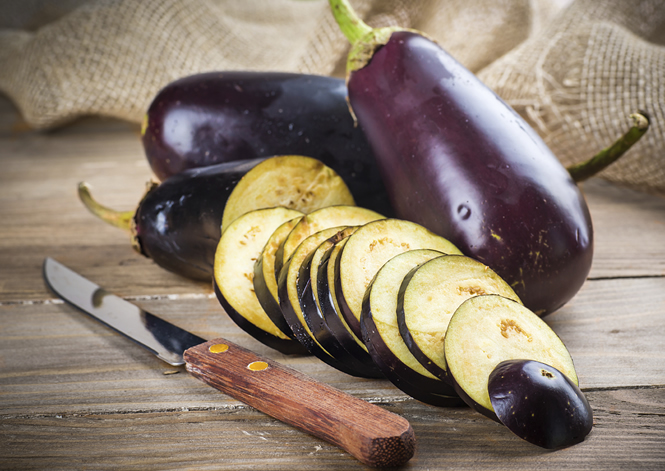
How to prepare aubergine
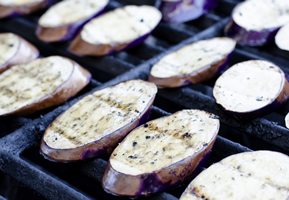 Aubergine
is perfect for grilling or barbequing due to its squishy texture, which
acts like a sponge and soaks up any oil or marinade (for this reason
it’s important not to use too much oil). It is also fast and easy as no
pre-boiling is required.
Aubergine
is perfect for grilling or barbequing due to its squishy texture, which
acts like a sponge and soaks up any oil or marinade (for this reason
it’s important not to use too much oil). It is also fast and easy as no
pre-boiling is required.
Peel the aubergine, if required, and cut into slices of about 1/2 inch, then brush each slice on both sides with olive oil. As well as adding flavour, this also keeps them from sticking to the grill rack.
Season with salt or Herbamare seasoning salt, pepper and herbs. You could also brush with a marinade of oil, lemon juice, garlic, chilli and herbs (or a mix of your choice).
Place the aubergine slices directly on the grill rack for about 8 minutes, turning once.
If barbequing, place the aubergine slices directly onto the grill rack over the coals at a medium heat and cook uncovered for about 8 minutes, turning occasionally.
How to roast aubergine
Preheat your oven to 180C / 356F
Peel the aubergine if required
Cut the aubergine into 1/2 inch slices or chunks
Drizzle with a little olive oil to coat
Add sea salt and any other seasoning as required (pepper, oregano, basil, thyme, fennel seed, garlic or Herbamare seasoning salt)
Spread in a single layer onto a pre-heated baking tray
Roast for 20 minutes in a conventional oven or 15 minutes in a fan-assisted oven.
How to fry/sauté aubergine
Brush slices of aubergine with a little olive oil on both sides and sprinkle with salt or herbamare and pepper
Heat about 2 tablespoons of olive oil in a large pan over a medium to high heat
Add your aubergine slices to the pan and fry for about 5 minutes per side or until golden
How to microwave aubergine
Peel the aubergine if required and cut into 3/4-inch cubes.
Season with salt or Herbamare seasoning salt, pepper and herbs (optional)
Place your cubes in a microwaveable dish with 2 tablespoons water, then cover.
Microwave on full/high power for 6 to 8 minutes or until tender, stirring once half-way through cooking.
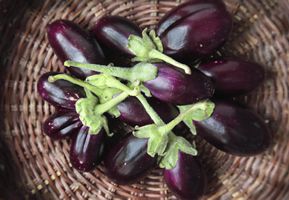 pasta,
risotto and all your favourite recipes). Due to its high water content,
cooked aubergine can also be frozen. Frying or roasting, then coating
it in flour, works well for freezing.
pasta,
risotto and all your favourite recipes). Due to its high water content,
cooked aubergine can also be frozen. Frying or roasting, then coating
it in flour, works well for freezing.
Whatever way you decide to cook your aubergine, there are so many wonderful recipes spanning different types of cuisine from across the globe, including moussaka, baba ganoush, ratatouille, parmigiana and stuffed aubergine, so why not give one a go tonight!

How to choose aubergine
Aubergines come in a range of colours, shapes and sizes and are at their best between July and September. You should choose an aubergine which has a firm, glossy skin and is smooth and unblemished.
How to prepare aubergine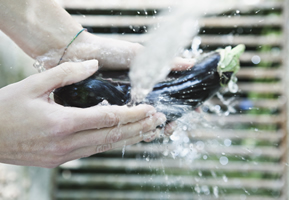
- Wash the aubergine.
- If the skin is smooth and unblemished you can leave it on. Older aubergines should be skinned however as the skin turns bitter. Use a peeler or sharp knife to remove the skin (as thinly as you can).
- Use the aubergine straight after peeling, otherwise the flesh will discolour.
- Cut the top and bottom ends off with a sharp knife.
- Cut into slices or cubes as desired (make sure the slices are not too thin and the cubes are not too small though, as this could result in disintegration when cooked).
- You can salt your aubergine before cooking (or sprinkle with some Herbamare seasoning salt). Whilst this isn't essential, it does reduce the bitter taste. You can also add pepper and/or herbs.
- If salting, place your slices or cubes on a plate or paper towel and sprinkle both sides.
- Ensure that your aubergine is dry before cooking by squeezing it with a paper towel. This will stop the aubergine absorbing any oil whilst cooking (if you are using it).
How to grill/barbeque aubergine
 Aubergine
is perfect for grilling or barbequing due to its squishy texture, which
acts like a sponge and soaks up any oil or marinade (for this reason
it’s important not to use too much oil). It is also fast and easy as no
pre-boiling is required.
Aubergine
is perfect for grilling or barbequing due to its squishy texture, which
acts like a sponge and soaks up any oil or marinade (for this reason
it’s important not to use too much oil). It is also fast and easy as no
pre-boiling is required.Peel the aubergine, if required, and cut into slices of about 1/2 inch, then brush each slice on both sides with olive oil. As well as adding flavour, this also keeps them from sticking to the grill rack.
Season with salt or Herbamare seasoning salt, pepper and herbs. You could also brush with a marinade of oil, lemon juice, garlic, chilli and herbs (or a mix of your choice).
Place the aubergine slices directly on the grill rack for about 8 minutes, turning once.
If barbequing, place the aubergine slices directly onto the grill rack over the coals at a medium heat and cook uncovered for about 8 minutes, turning occasionally.
How to roast aubergine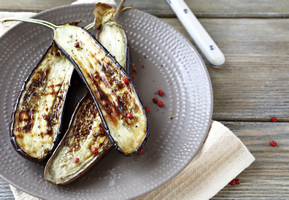
Preheat your oven to 180C / 356FPeel the aubergine if required
Cut the aubergine into 1/2 inch slices or chunks
Drizzle with a little olive oil to coat
Add sea salt and any other seasoning as required (pepper, oregano, basil, thyme, fennel seed, garlic or Herbamare seasoning salt)
Spread in a single layer onto a pre-heated baking tray
Roast for 20 minutes in a conventional oven or 15 minutes in a fan-assisted oven.
How to fry/sauté aubergine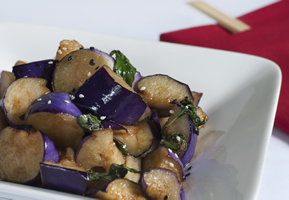
Brush slices of aubergine with a little olive oil on both sides and sprinkle with salt or herbamare and pepperHeat about 2 tablespoons of olive oil in a large pan over a medium to high heat
Add your aubergine slices to the pan and fry for about 5 minutes per side or until golden
How to microwave aubergine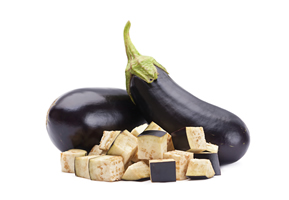
Peel the aubergine if required and cut into 3/4-inch cubes.Season with salt or Herbamare seasoning salt, pepper and herbs (optional)
Place your cubes in a microwaveable dish with 2 tablespoons water, then cover.
Microwave on full/high power for 6 to 8 minutes or until tender, stirring once half-way through cooking.
Storage
Cooked aubergine can be stored in an airtight container in the fridge for up to 5 days (at the ready for adding to salads, pasta,
risotto and all your favourite recipes). Due to its high water content,
cooked aubergine can also be frozen. Frying or roasting, then coating
it in flour, works well for freezing.
pasta,
risotto and all your favourite recipes). Due to its high water content,
cooked aubergine can also be frozen. Frying or roasting, then coating
it in flour, works well for freezing.Whatever way you decide to cook your aubergine, there are so many wonderful recipes spanning different types of cuisine from across the globe, including moussaka, baba ganoush, ratatouille, parmigiana and stuffed aubergine, so why not give one a go tonight!
No hay comentarios:
Publicar un comentario